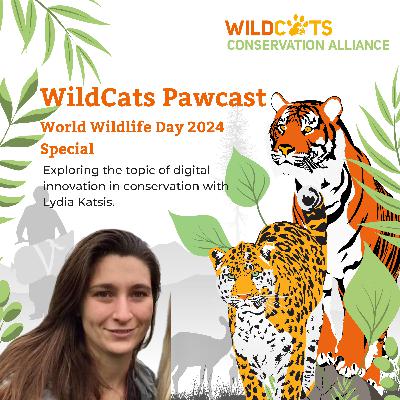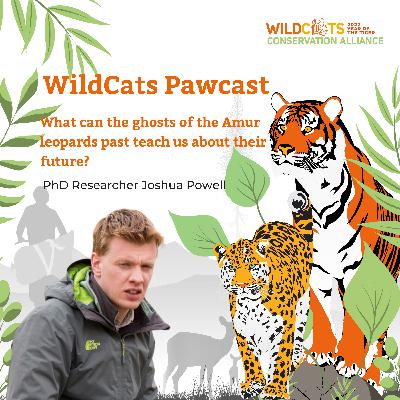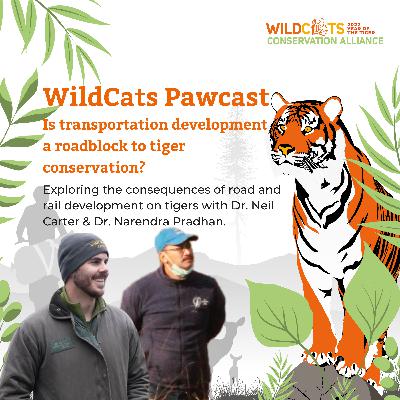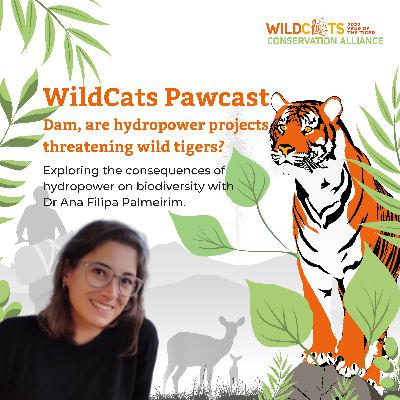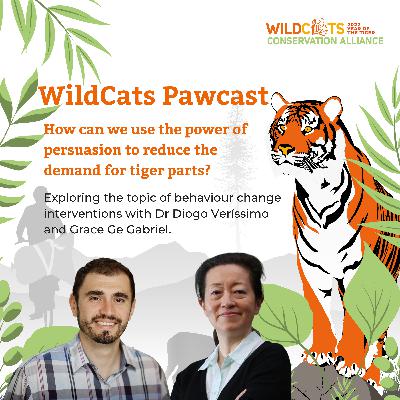Discover WildCats Pawcast
WildCats Pawcast

WildCats Pawcast
Author: WildCats Conservation Alliance
Subscribed: 3Played: 65Subscribe
Share
Description
Welcome to "WildCats Pawcast," the podcast show created by WildCats Conservation Alliance which is dedicated to the preservation of two majestic and endangered big cat species - wild tigers and Amur leopards. Join our host, Amy van Gelder, as she embarks on an inspiring journey to raise awareness about the critical issues threatening these magnificent creatures and their habitats.
In each captivating episode, "WildCats Pawcast" takes you on an immersive exploration into the world of tiger and Amur leopard conservation. From remote rainforests to vast grasslands, each habitat poses unique challenges to the survival of wild tigers and Amur leopards. Joined by global experts, our show delves deep into the threats they face, from poaching and habitat loss to human-wildlife conflict and climate change. We also examine the multifaceted strategies and innovative solutions being implemented to safeguard the future of these beautiful big cats.
"WildCats Pawcast" not only educates but also empowers you to make a positive impact. Through inspirational stories and actionable insights, we invite you to become a part of the global movement to protect wild tigers and Amur leopards. Together, we can preserve these incredible species and the delicate ecosystems they call home.
In each captivating episode, "WildCats Pawcast" takes you on an immersive exploration into the world of tiger and Amur leopard conservation. From remote rainforests to vast grasslands, each habitat poses unique challenges to the survival of wild tigers and Amur leopards. Joined by global experts, our show delves deep into the threats they face, from poaching and habitat loss to human-wildlife conflict and climate change. We also examine the multifaceted strategies and innovative solutions being implemented to safeguard the future of these beautiful big cats.
"WildCats Pawcast" not only educates but also empowers you to make a positive impact. Through inspirational stories and actionable insights, we invite you to become a part of the global movement to protect wild tigers and Amur leopards. Together, we can preserve these incredible species and the delicate ecosystems they call home.
12 Episodes
Reverse
Join us this World Wildlife Day as we delve into the cutting-edge realm of digital innovation in wildlife conservation! In this special episode, we are thrilled to be joined by Lydia Katsis, Senior Technical Specialist at the Zoological Society of London’s Conservation Technology Programme. From advanced tracking technologies to innovative data analytics, we uncover the diverse digital solutions driving wildlife protection into the future. However, amidst the excitement of technological progress, a stark reality looms: an estimated 3.7 billion people, nearly half of the world’s population, lack access to the Internet. This gaping digital divide disproportionately affects the least developed countries, which ironically harbor the richest biodiversity. This presents a formidable challenge in harnessing the full potential of digital technologies for collective conservation efforts. In our quest to safeguard species teetering on the brink of extinction, we must prioritize equal opportunities for all. Our mission extends beyond wildlife preservation; it encompasses fostering digital inclusion by 2030. Join us as we unravel the critical intersection of digital advancement and wildlife conservation, forging a path toward a more inclusive and sustainable future for all inhabitants of our planet.
In this episode, we're celebrating Women and Girls in Science! Join us as we discuss how the exclusion of women from knowledge production hampers our ability to address global challenges like biodiversity loss effectively. We explore how one female mathematician exemplified the transformative insights women bring through her crochet-based solution to a problem that had stumped the world’s leading minds for years. We also delve into the importance of valuing both social and natural sciences equally, explore the gender bias in academic disciplines, and speak with Anna Klevtcova, recipient of the WildCats Conservation Alliance's Professional Development Award. Anna shares insights on her interdisciplinary research, the challenges women face in academia, and the need for support in balancing research and family. Join us as we advocate for women in science.
In this episode, we will be discussing what historical records of Amur leopards in Seoul, Korea, at the end of the 19th century, can tell us about the future of large carnivores in major urban centers with a high human population density. We're joined by PhD Researcher Joshua Powell whose research investigates opportunities and challenges for the transboundary conservation of the Endangered Amur tiger, leopard, and other large carnivores in north-east Asia. Joshua is a visiting researcher with the Tiger and Leopard Conservation Fund in Korea (KTLCF) and has been a visiting research student in the College of Veterinary Medicine at Seoul National University. He is a National Geographic Explorer and one of the faces of WWF’s Voices campaign on global biodiversity. In this episode, we will be focusing on his paper on the historical context of Urban Leopards in the Early Anthropocene From Seoul, Korea. His paper explored the socio-cultural, political, and ecological factors that may have facilitated human-leopard co-occurrence in an urban landscape and the factors that eventually led to the leopards' extirpation.
The construction and expansion of roads and railways fragment wild spaces and have direct and indirect impacts on ecosystem integrity and the persistence of species, especially in areas of high biodiversity value. The length of legally sanctioned roads alone has increased by 12 million km worldwide since 2000, with a further 25 million km expected to be developed globally by 2050 — that’s enough to circle the planet more than 600 times. Roughly 90% of these new roads will be built in developing nations, frequently in tropical and subtropical regions with high biodiversity and environmental value. Currently, it is known that 134,000 km of roads already exist within tiger habitats and 24,000 km of new roads will be built by 2050 within these tiger territories. So, in this episode of WildCats Pawcast, we are speaking with two of the authors from a recent paper that has forecasted the effects of transport infrastructure on endangered tigers. Join this episode to hear from Dr. Neil Carter, an Associate Professor from the School for Environment and Sustainability at the University of Michigan, and Dr. Narendra Pradhan, the Programme Coordinator at the International Union for Conservation of Nature (IUCN) in Nepal.
While we are all too familiar with the catastrophic footprint fossil fuels have left on the environment and our health less is known about some of the impacts of renewables on our wild spaces and biodiversity. In this episode, we will be hearing more about how a low-carbon, renewable solution to rising global energy demands fails to fully consider impacts on biodiversity, freshwater connectivity and local communities. We are joined by Dr Ana Filipa Palmeirim, an Ecologist and Postdoctoral Researcher at the University of Porto. Filipa recently published a paper on the impacts of hydropower on the habitat of jaguars and tigers. This paper revealed more than one-fifth of the world’s tigers had been affected by habitat loss linked to hydropower projects.
This month we’re bringing you a special episode of WildCats Pawcast in celebration of World Photography Day. If you’re an aspiring wildlife photographer or just want to learn more from behind the lens this episode has the perfect mix of inspiration, creativity, and technical advice. Photography not only makes the world feel closer, but it also inspires people to care, making it an incredible tool for conservation. Tigers, specifically the Bengal tiger in India, have been extensively documented by photographers who have showcased the magnificence of these animals to a global audience. But beyond beautiful images, photos have also provided graphic evidence of our devastating impact on habitats and species which has helped to drive action in a worldwide community. Across the world, wildlife photographers are using the power of pictures to help save endangered species. In this episode, we are joined by an amazing photographer and longtime friend of WildCats Conservation Alliance, Tal Chohan. Tal is a UK-based photographer who specialises in big cat photography. He has been pursuing this passion for over a decade, first honing his skills in zoo settings before capturing wildlife in their natural habitats at home and abroad. For over a decade Tal has been supporting us at WildCats and you can explore more of his work over on Instagram or his website.
Welcome back to episode 5 of WildCats Pawcast brought to you by the WildCats Conservation Alliance and hosted by Amy van Gelder. To celebrate Global Tiger Day on the 29th of July, we recruited some inquisitive kids to help record our Pawcast. Amid the who, what, where, why and how, children are often asking the most important and challenging questions. So, in the latest episode of WildCats Pawcast, we have handed the metaphorical podcasting microphone over to some of the world’s most enquiring minds. But, can leading tiger experts withstand the interrogation? Join Dr. Dale Miquelle from the WCS, Debbie Martyr from FFI and Sashank Sharma from ZSL Nepal as they fearlessly take on these curious cubs.
Just like many other conservation issues, the illegal wildlife trade originates from the actions and choices of people, so, to help solve the problem, we need to mobilise changes in human behaviour. In this episode we talk to Dr Diogo Veríssimo, a Research Fellow at Oxford University for the Oxford Martin Programme on the Illegal Wildlife Trade and Grace Ge Gabriel, IFAW’s Regional Director for Asia. Join us as we look into demand reduction activities that use behaviour change interventions as an approach to reducing the purchase and consumption of tiger products. Additional reading: Making more effective use of human behavioural science in conservation interventions - ScienceDirect Biodiversity conservation as a promising frontier for behavioural science | Nature Human Behaviour Using theory and evidence to design behaviour change interventions for reducing unsustainable wildlife consumption - Doughty - 2021 - People and Nature - Wiley Online Library The Society for Conservation Biology (wiley.com) Influencing consumer demand is vital for tackling the illegal wildlife trade (researchgate.net)
In our third episode, we are exploring the criminal underworld of the illegal wildlife trade. Raking in up to an estimated $23 billion a year according to the UN, the international wildlife trade is one of the most lucrative transnational organised crimes. Ivory, rhino horn and tiger parts are among the most popular large animal “commodities” that are trafficked by criminal networks involved in the illegal trade. Today, we are left with fewer than around 4000 tigers living in a meagre 4% of their historic range compared with the 100,000 wild tigers who roamed across Asia just over a century ago. And yet, there is no respite for this heavily persecuted species with an estimated 2 tigers seized per week since the turn of the century. We are joined by Debbie Banks, the Tiger and Wildlife Crime Campaign Leader for the Environmental Investigation Agency (EIA). From undercover operations exposing the illegal tiger trade to working with governments to improve policy and commitment, Debbie has dedicated more than 20 years to protecting tigers. She has worked on projects and investigations in India, Nepal, China, Thailand, the USA, Europe and Japan and has trained numerous investigators to continue her legacy. You can read more reports on the illegal wildlife trade from the EIA here.
Welcome to episode two of WildCats Pawcast, the show which brings you closer to experts from around the world working to save wild tigers and their habitats. Today we’re going to be taken deep into the world of tigers as we explore the subject of population monitoring which is very topical during this Year of the Tiger. Confronted with the dire situation facing wild tiger survival back in 2010, world leaders and conservation practitioners met to discuss strategies for tiger recovery. This meeting was a first in human history where country leaders converged to discuss the conservation of a single species. The outcome was a Global Tiger Recovery Program that outlined strategies to double tiger numbers by the next Year of the Tiger in 2022. And here we are, it’s 2022. 12 years have passed and what happened to that goal to double wild tiger numbers? Ahead of this year’s global tiger count we are joined by Dr Jhala, the dean and a senior professor at the Wildlife Institute of India and Dr Abishek Harihar, a population ecologist and assistant director of Panthera’s Tiger program. They explain the history of counting tigers and how baselines were set. We hear how these methods have developed over the years and the benefits and challenges this has created. Dr Jhala gives us an eye-opening insight into India’s Guinness World Record holding tiger count and we hear from Dr Harihar about some of the challenges associated with estimating global tiger numbers.
Welcome along to the first episode of WildCats Pawcast, a brand-new podcast from WildCats Conservation Alliance. To kick the series off, this month we're jumping straight in with the topic of diseases. While global attention is currently focused on COVID-19, a disease that has jumped from animals to humans, it is important to remember that diseases that breach the species barrier also pass from people and their domestic animals to wildlife populations. And this poses a serious threat to endangered species like tigers who are already teetering on the brink of extinction. In this episode I am going to be joined by the Deputy Country Director for the Wildlife Conservation Society’s Indonesia Program Dr Matthew Linkie, Freeland Foundation’s Surviving Together Program Director Tim Redford and wildlife veterinarian and epidemiologist Dr. Martin Gilbert from Cornell University. We discussed the top three infectious diseases which are having an impact on tigers, including indirect threats from African Swine Fever and Lumpy Skin Disease to the more direct impacts of Canine Distemper Virus.
12 years ago, there was a very real risk that tigers would become extinct in the wild, however, we are finally seeing their numbers increase across their range in Asia thanks to coordinated and concerted conservation efforts, but they’re not out of the woods yet. In honour of Year of the Tiger in the lunar calendar which begins on February 1st WildCats Conservation Alliance are dropping this Pawcast dedicated to tigers. On the last Year of the Tiger in 2010, leaders of the 13 tiger range countries assembled at an International Tiger Forum to set out the Global Tiger Recovery Program. Their overarching goal was to double the number of wild tigers across their geographical area by the next Year of the Tiger in 2022. That is where this series comes in. To celebrate this monumental year for tiger conservation WildCats delve into current issues affecting the preservation of this majestic species. In each episode, you'll meet with experts from around the world working to save wild tigers and their habitats and take a deeper dive into the threats and solutions affecting the future of the species. From deforestation to climate change, illegal wildlife trade to human-tiger conflict, WildCats will be exploring a different key issue in every episode. Join the conversation on social media by searching for ‘Conserve WildCats’ on Twitter, Facebook and Instagram. And make sure you subscribe to WildCats Pawcast wherever you get your podcasts so that you never miss an episode.


